Deathcrash: “Making this album was sensationally slowcore”
The London post-rock group headed to the edge of the world to create their latest record
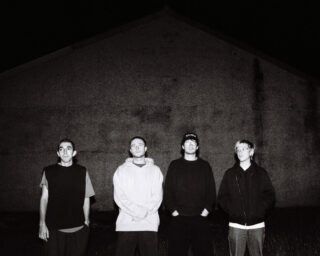
The London post-rock group headed to the edge of the world to create their latest record
On a crisp-cold December evening ducks line the towpath of Regent’s Canal and hop onto floating ice blocks with the strange regularity of hailed city cabs. It’s a fantastic scene to witness from the top deck of a slow bus navigating the diversions of East London: a fleet of glacial shapes drifting down the watery thoroughfare, rocking to-and-fro like an old pub table.
A few streets away in the low-glow cordiality of the Chesham Arms, London-based slowcore quartet Deathcrash nestle around a table, where the warmth takes everyone and their glasses by surprise. Bassist Patrick Fitzgerald works in a nearby café and passes around a stale end-of-shift croissant in a paper bag. “We’ve been told we’re a wintry band before,” says drummer Noah Bennett. “I was wondering if now’s the time people listen to us.”
Their debut album, bashfully titled Return, certainly fits the season: unhurried guitars skulk up to an echoing kick drum, and vocalist/guitarist Tiernan Banks’s muffled words nest into the small breaks of reverb like a fledgling bird. Their songs stroll gently across an hour’s pasture, unassertive but not without purpose. In its more laconic moments Return sounds like Slint’s Spiderland blasted through thin walls, only to rumble into billowing crescendos and unintelligible screams.
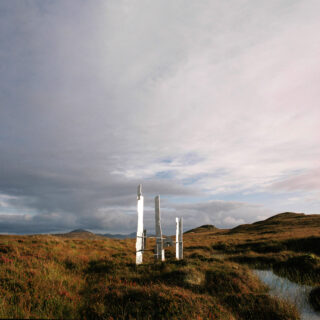
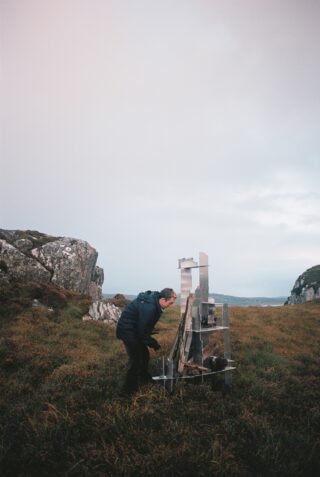
“There was this German review of the album that said, ‘put on Return, lie down in a dark room and wait until it hurts…’” laughs guitarist Matthew Weinberger. “Like shit, maybe we need to lighten up a little. December’s a weird month to be a band. The industry kind of shuts down, everyone does their end of year lists, we stop rehearsing at some point to hang out with our families…”
“We’re really very busy reading all the end of year lists,” Banks interjects. “It’s a journey, looking down, album by album, only to realise we’re in none of them.”
“You don’t have to read it album by album,” says Weinberger. “Ctrl + F + Deathcrash.”
“We didn’t make Loud and Quiet’s one either,” Banks smiles generously. “That’s fine. Let’s deal with that elephant in the room now. Although I think we made it into one of those lists, you know, albums you haven’t heard of.”
“It’s been a dry couple of months,” says Fitzgerald, seeming grateful for the pause. “We’ve finished recording the new album and just settled into everything. It’s been our first time off for a while and there’s no sense of massive pressure; we’ve got this show booked in for March (at London’s ICA), and we’re just slowly working towards things like that.”
There’s a tender self-depreciation between the four bandmates. Several times they remind each other to stop saying how badly they’re doing, if just because of tired comparisons with former South London contemporaries they’re apparently not keeping pace with. They’re not trying to. In an interview with Dan Carey a few years ago, Deathcrash were described as the weird, dark partners to the Windmill scene; they seem to enjoy working in their own lane.
I first saw the band live at St. Matthias Church in Stoke Newington on a socially-distanced summer night, where the rain poured sideways and stern wardens refused to open the looming doors a minute early. Played in the dark with a solitary spotlight beaming down the middle aisle, it was a rare show that felt meticulously curated; venue, band and unrelenting wall-of-sound becoming a single circumstance. The years since have taught them how to perform a little more, too, following a series of outdoor festival shows in the Netherlands.
“We thought it’d be a bit weird to be playing outside to all these people wanting to have a good time,” says Banks, “but it turns out you can enjoy Deathcrash all year round.”
“We came to appreciate the niche we fill at festivals,” adds Fitzgerald. “It’s nice to feel confident in that role, knowing that no one’s coming to us to have a dance.”
Their live run over last summer ended with a momentous set at End Of The Road festival, playing to their biggest crowd yet. After months of dodgy linechecks through headphones, filling kick drums with unsold t-shirts and compromising volume levels, it felt like a triumph of their newfound confidence, forgoing total perfectionism, instead playing loud and heavy among the low-hanging clouds of dry ice.
“Sometimes it feels like we’ve conned people into coming,” muses Weinberger. “Did they mean to be here? You can see people, but they’re not moving.” He crosses his arms and slides shoulder-to-shoulder with Noah. “It’s always like, fuck, I really hope they’re enjoying this.”
“The perfect show for us is complete silence,” says Bennett. “That was the crazy thing about End Of The Road: the moment in the set when it first went quiet, we all realised that everyone was actually listening. That was scary.”
“We still care a lot about where we play,” Banks emphasises, cautious to stress that they’re not abandoning churches for cider-sponsored stages at Richard Branson’s next soiree, “but it comes from a less anxious place now.” They remember the run of socially distanced shows they played in the aftermath of their breakthrough EP, People thought my windows were stars.
“I remember Geordie from Black Midi coming along to one of them,” says Weinberger. “He said something to Tiernan like, ‘yeah that was interesting. I don’t know if I liked it. I need to think about it.’ We called it the TV dinner tour, where people would get food delivered to their table. We’d be really going for it, building up to the perfect quiet period only for a waiter to shout, “burger and fries?” – it shattered the whole thing completely.”
“It wasn’t a burger; it was a dirty hot dog.” Banks shakes his head. “Yeah, that was bad.”
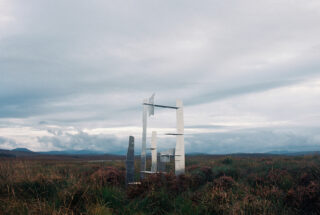
Deathcrash’s second album, Less, is set for release this March on untitled (recs). It was recorded over two weeks in the Outer Hebrides at Black Bay Studios – an old crab factory renovated into the most remote recording studio in the UK.
“It wasn’t just on an island,” smiles Banks. “It was on an island off an island with 200 residents. There was nothing there. It was amazing.”
It took them 36 hours to arrive, too, camping in the Cairngorms after a day’s driving, pitching their tents in a heavy storm while their amps stacked precariously against the sides of their van, under foggy peaks and aubergine-purple mountains.
“I don’t know how to express this in a way that doesn’t sound weird,” says Weinberger, “but it kind of felt momentous. For us, at least, historic. Holing ourselves up in this place away from everything with the chance to record this emotionally raw album… We wanted to make it an occasion. Once we knew Black Bay Studios existed, we had to go there.”
“There was a chart on the studio wall of bands who’d stayed,” Banks grins, “a league table of who’d gone out swimming the most.”
“Some of us went swimming every morning,” chimes Bennett.
“No, I want it going on record that we lost. We swam by far the least.”
“Anyone who did well on that chart is a slacker,” nods Fitzgerald. “We’re proud of our loss. If you’re swimming two or three times a day… I don’t want to cast any aspersions, but did you make a good album?”
The time out of water served Deathcrash well. Opening with the Caroline-like warm-up ‘Pirouette’, Less is a spectacular work of wrath and restraint. It’s both a steam train hurtling towards the mouth of a tunnel unsure of its exit point and the scenic rumble when it emerges into daylight. You can hear the lineage of ’90s DIY to maximalist post-rock – Sebadoh’s Bubble and Scrape to Chemikal Underground-era Mogwai – lurking in its silences. ‘Empty Heavy’ helixes thrash into an outro more closely approximating The Antlers, ‘Duffy’s’, ‘And Now I Am Lit’ and ‘Distance Song’ are tender moments of exhalation, while album standout ‘Turn’ transforms opulent instrumentals into domineering screamo, a confluence of claustrophobic guitars and vocals bending like trees over a fugitive melody.
Weinberger talks of the Baader-Meinhof phenomenon – the feeling that something is happening more frequently than it really is – manifesting itself in their relationship with slowcore; their exposure to the genre has made the band see it everywhere lately, perhaps especially since the tragic passing of slowcore pioneers Low’s Mimi Parker. But in the UK, at least, few bands would be considered Deathcrash’s classmates – the mantle is theirs to carry. At the risk of hyperbole, Less feels as close to a definitive document of UK slowcore as you could hope for. Its sound is gently refined, yet still wanders undaunted into the sprawling nothingness. But it’s also the first time they’ve recorded music with any knowledge that someone will listen.
“I think the pressure of it all got to me sometimes,” admits Banks. “Previously we were deeply invested in Deathcrash in a private sense. But this was the first time we’d had to do the public and the private at the same time. We were recording vocal takes whilst we were booking shows. Like, what if we leave here and we hadn’t done it right?”
“It’s just that thing when you’re sitting in a studio listening over what you’ve done for the last eight hours, trying to figure out if any of this is good enough or not,” agrees Fitzgerald. “Sometimes we’d spend all day on a song and think ‘Yeah that’s it!’, then wake up in the morning and lose all faith.”
“We had the name for the album two songs in,” says Bennett. “Once we’d settled on it, it became clear that that’s what we were going to do with this record. A record of less. It forced us to condense.”
“The initial concept was just ‘songs for m, i-iv’ [tracks from People thought my windows were stars], but better,” says Banks. Those four tracks were early standouts in their discography – sparse and gently building from soft acoustic guitars and cymbals to plinking post-rock, thick in the unresolved nostalgia of cult San Jose band Duster and their sideshow Valium Aggelain.
“It was a respite from doing Return, which felt heavy and long and hard,” explains Fitzgerald. “We just felt like there was no way we could make that album again. Less was almost like a defence mechanism. Just the four of us in a room making music with no pressure. But then you just start thinking, ‘Hang on, this is cool, let’s make it heavier.’”
“Yeah, what if we just… vrmmm.” Weinberger simulates a thrash chord, turning up the imaginary volume dial. Nobody said slowcore bands can’t air guitar. “The result is quite exposed. They’re these tightly conceived songs just blasted out live into the uncertainty of the room.”
“Do you think it’s less chin stroke-y?” asks Banks. “Maybe it’s more emotionally immediate.”
“Well we went into it with the mindset of making a Deathcrash pop album,” laughs Fitzgerald. “I was convinced it was this emo pop record. Slow-mo.” [Reader, that’s slowcore-emo.]
Moments of Less are certainly as bleak as Return. Bennett shakes his head, smiling. “We were really annoyed when we all sat down, listened back and realised we’d made another dark and heavy album.” The ominous ‘Empty Heavy’ topples a gorgeous guitar riff into dense sludge with little warning; ‘Dead, Crashed’ hurtles into post-rock-come-doom metal, while the one moment of confused optimism at the close of ‘Turn’ dissolves Banks’s ruminating refrain – “it hurts much less” – into a crumbling death spiral.
“I think there’s a lot more rawness in this,” reasons Weinberger. “Before we wanted to gesture at something, but Less is wanting to show the immediacy of what this shit feels like. Everything we wanted from this record was a sense of place and purpose. When I listen to the album, I hear those two weeks. I hear the time and the place and the togetherness.”
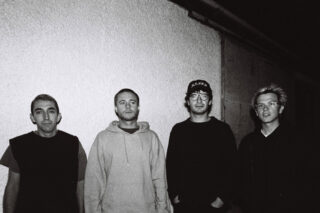
Everyone had their moments of personal reckoning at Black Bay, and found their own remedies; Patrick would go on runs with the band’s manager, Tiernan would walk up the road to the nearest rock and stand with his thoughts – a slowcore wanderer over a sea of fog – on an island with no paths, where it took an hour to travel a few hundred yards cross country. Noah swam.
“It was sensationally slowcore,” laughs Banks. “The slowest of cores. And the whole thing had this sense of occasion as a result for sure. Our music is always sincere; sometimes it’s sad, sometimes intense and sometimes frightening. But we had to live those things. It was good to have this place far away, not at all enmeshed with our real lives.”
“I think it’s music that naturally has this gestalt,” says Weinberger. “You know, it’s more than the sum of its parts. You’ll only ever hear three instruments at a time, but the more you listen, the more it hopefully becomes this huge indistinguishable thing and you’re just left with an emotion.”
“It definitely requires a lot from people,” Banks says. He pauses. “I hadn’t thought of that.”
The band also brought their friend and artistic director Kaye Song to the island, to create the artwork for Less in tandem with the album being recorded.
“She had designed this modular sculpture in London,” explains Bennett, “you could put it together in loads of ways. Her and our manager Joe took this thing on a tour of the island and put it together in different spots. By its nature each time it’d take a slightly different form. At the end of each day we’d all have dinner and see where it had been… It started to take on its own personality.”
“It was awesome to have a second creative process happening alongside us,” adds Banks. “I think that really saved us from our own madness. Every night it was like a family where the parents get to listen to what the kids did at school that day.”
It gave them some element of perspective, too. When they’d had a difficult day, they’d see Kaye and Joe wearing longjohns and wetsuits, holding this sculpture in the middle of a lake. The band had a go at assembling the sculpture once, too, which was pictured for the back cover of the album. “It was an absolute monster,” smiles Bennett. “It looked horrific.”
Lyrically, Less is an abstract search for self. “It was a time in my life when I was starting to wonder whether all these things that defined who I was in some sense weren’t all that good for me,” says Banks, stumbling a little. “To what extent, when you change your relationship to these things, what does that make you at the end? Pat’s good at explaining this. The location, the music, the lyrics, stripping it back, it’s all a response to what we’ve done before.”
“I guess when things are changing, you’re desperately trying to hold onto things too,” Fitzgerald clarifies. “It was just less. Not less is more, less is sometimes just less.”
“It’s just less,” repeats Banks. “A lot less. Less time, less money?” he laughs. “Less prospects for the future?”
Photograhy by Kaye Song